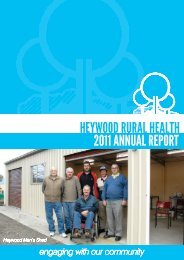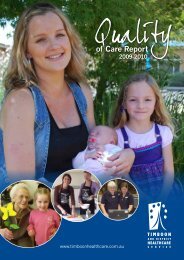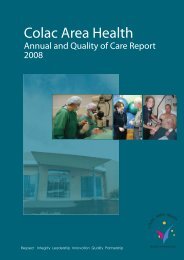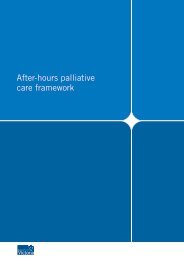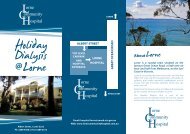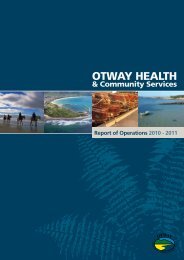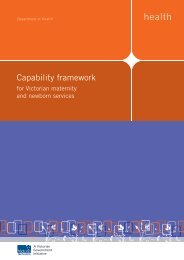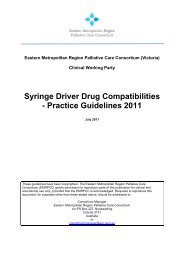ADVANCED LIFE SUPPORT LEARNING PACKAGE
ADVANCED LIFE SUPPORT LEARNING PACKAGE
ADVANCED LIFE SUPPORT LEARNING PACKAGE
You also want an ePaper? Increase the reach of your titles
YUMPU automatically turns print PDFs into web optimized ePapers that Google loves.
SOUTH WEST HEALTHCAREWARRNAMBOOL<strong>ADVANCED</strong> <strong>LIFE</strong> <strong>SUPPORT</strong><strong>LEARNING</strong> <strong>PACKAGE</strong>Prepared by:J. Brown, ICULast revised February, 2010.C. Joseph, Nursing Education.
CONTENTS:Page:Objectives 3-5Basic Life Support 6-8Choking and airway obstruction 8-9Defibrillation in ALS 9-11Automated External Defibrillators 12Temporary external pacing 13-16Medications used in ALS 17-23Treatment of arrhythmias 23-26Correcting reversible causes 26References 272
OBJECTIVES:1. Demonstrate / describe what constitutes effective BLS:• Assessment of airway• Breathing• Circulation / Compressions• Demonstrate the above on manikin2. Give the rationale for early defibrillation, early access to theemergency response system and early BLS.3. Recognises those rhythms that require defibrillation and thosethat do not.4. Describe the protocol for the use of a defibrillator in both themanual and Automated External Defibrillator (AED) mode.5. Give the rationale for the use of and indications for deliveringeither a single shock or a series of 3 rapid stacked shocks.6. Demonstrate techniques which provide access to appropriateskin sites for placement / attachment of the defibrillator electrodesand:• Describe when it might be necessary to dry the skin• Demonstrate preparation of defibrillator electrodes forattachment to the skin.• Describe the technique to avoid trapping of air between theelectrodes and the skin.• Attach the electrodes to the skin at appropriate sites in amanner that facilitates safe and effective defibrillation.3
7. Demonstrate electrode placement on either a manikin whichgenerates an ECG signal, or to a separate ECG signal generator,including:• Turning on defibrillator / attaching electrode cable todefibrillator.• The technique for initiating analysis of the ECG signal in theAED mode.• The technique for charging the defibrillator.• When AED mode in use, deliver first shock when promptedto do so.• The delivery of a shock after giving a warning for bystandersto stand clear.• The provision of further shocks and Basic Life Support (BLS)according to SWH protocol and by prompts from the AED,including the prompt that a non-shockable rhythm is present.The participant should demonstrate preparation of AED,attachment of the electrodes to manikins chest etc. in a twominute time frame. The participant must also demonstratehow to operate the AED in the manual mode (Critical Careand Emergency trained staff only).8. Demonstrate appropriate responses to perfusing and nonperfusingrhythms on a manikin that generates various rhythms forinterpretation. In the case of the manual biphasic defibrillator, theparticipant must demonstrate use, response to rhythms, selectjoules, charge, defibrillate and demonstrate use and understandingof all buttons on the defibrillator.9. Describe the possible complications of external defibrillation.10. Describe the safety precautions of defibrillation, including theimportance of the “stand clear” command.4
11. Describe the possible problems which may arise during theuse of the defibrillator and how to respond to such problems.12. Demonstrate a maintenance check of and basic fault finding ina defibrillator:• Checking leads for damage.• Turning on the defibrillator to check for potential function.• Checking the presence of paper in the paper drive and thatthe electronic data collection module is in place.13. Outline troubleshooting of the defibrillator when there is failureto discharge or failure to defibrillate..14. State the steps in the ALS algorithm and the points at whichmedications are appropriate.15. Choose the most appropriate drug or drugs in light of:• The point that has been reached in the ALS algorithm.• The cardiac rhythm.• The duration of the arrest.• The patient’s serum electrolyte levels and acid-base status.• The patient’s response to drugs, which have already beenadministered.• The patient’s history and previous medication exposure.• Identify the need to exclude reversible causes and identifythese causes.16. State the initial dose of the selected drug, different modes ofadministration including the use of minijets, time to onset ofaction, likely duration of effect, subsequent doses, maximumdoses, side effects and management of side effects.5
BASIC <strong>LIFE</strong> <strong>SUPPORT</strong>Definition:The preservation and restoration of life by theestablishment of and/or maintenance of airway,breathing and circulation and related emergencycare.D - Danger:• The area should be assessed for any signs ofdanger for the patient and/or bystanders. Removethe source of danger if possible.R - Response:• Check the patient for a response, touch andshout!• Call for help, call a Code Blue, dial 33, andstate patient location.• Note the time of the event.A - Airway:• Check patency of the airway, look inside theairway for any signs of obstruction, clear orsuction the airway if required.• Insert Guedel airway if required, measure frompatients ear to lip.B - Breathing:• Look, listen and feel for any spontaneousrespirations.• Perform the head tilt/chin lift (not in infants).• Administer two good breaths with Laerdal bag.Ventilation oxygenates the patient.• Assist Doctors to intubate the patient if required.6
C - Circulation:• Check for a carotid pulse, located at the corner of themouth and half way down the neck. Do not spend morethan 10 seconds trying to locate the pulse.• For a witnessed or monitored arrest a precordial thumpshould be administered.• Attach FR2 automatic defibrillator if on general ward andfollow prompts from the machine.• If in ICU, ED or OR attach the HeartStart XL defibrillator.• It is important to continue CPR when the patient has nooutput, as this helps cellular perfusion and the circulationof drugs. Avoid interruptions to CPR, if interruptions occur,for example ALS interventions, 2 minutes of uninterruptedCPR must be performed before performing any furtherinterventions.• Check for output during CPR by palpating either thecarotid or femoral pulse.• Reassess the patient’s rhythm and for signs ofspontaneous output every 2 minutes.COMPRESSION/VENTILATION RATIOS:• Adult ratio: 30:2 compressions / ventilations for one ortwo operators, aiming for a rate of 100 compressions/minute.• Paediatric ratio (all ages except newborn): 15:2compressions / ventilations for one or two operators.• Newborn ratio (first minutes to hours after birth): 3:1compressions / ventilations for one or two operators,providing a rate of 120 compressions and 40 – 60 breaths/minute. Note the newborn period is the first minutes tohours after birth.Compression techniques:• Compress the centre of the patient’s chest with the heel ofboth hands. It is now recommended by the AustralianResuscitation Council (ARC) to use both hands for adultsand children except in infants and newborns.7
• The compression should be 1/3 of the depth of the chestfor all patients, which is 4-5cm.• Compressions for infants (1 year of age.Some injuries have been reported with the use of abdominalthrusts therefore the ARC no longer recommends the use of lateralchest thrusts.Assess SeverityThe simplest way to assess the severity of a FBAO is to assesswhether the cough is effective or ineffective.Effective Cough (mild obstruction):The victim with an effective cough should be reassured andencouraged to keep coughing to expel the foreign body.Ineffective Cough (severe airway obstruction):Conscious Victim:• Perform up to 5 sharp back blows with the heel of onehand in the middle of the back between the shoulderblades.• Check to see if each back blow has cleared theobstruction. An infant may be placed in a head downposition prior to giving the back blows.8
• If the back blows are unsuccessful the rescuer shouldperform 5 chest thrusts, checking to see if each thrusthas relieved the obstruction. To perform chest thrustsidentify the same compression point as for CPR andgive 5 thrusts. The infant should be placed in a headdown supine position. If the obstruction is still notrelieved continue alternating 5 back blows with 5 chestthrusts.Unconscious Victim:• The finger sweep can be used in the unconscious victimwith an airway obstruction if the foreign body is visible. ACode Blue should be activated and CPR commencedimmediately if the victim is unconscious and the rescuer isunable to remove the foreign body._____________________________________________________<strong>ADVANCED</strong> <strong>LIFE</strong> <strong>SUPPORT</strong>Defibrillation in advance cardiac life support:Research has shown that early defibrillation in cardiac arrest forpatients presenting with VF and pulseless VT dramaticallyincreases the chance of survival. A direct current passed throughthe patient’s chest can produce simultaneous depolarisation ofmyocardial cells leading to organised electrical activity. Researchhas shown survival decreases by 5.5% per minute without theinitiation of defibrillation, BLS and ALS.SWH has Philips HeartStart XL defibrillators, located in ICU, AcuteCare, E.D and the Operating Theatre. These can be used inmanual and semi-automatic modes. The remainder of the hospitalhas Philips FR2 automatic defibrillators that may also be operatedin manual mode (by Critical Care or Emergency trained SWHstaff). All the defibrillators are bi-phasic meaning the electricalenergy travels back and forth between the adhesive pads. Thisreduces the impedence of the chest wall allowing fewer joules tobe used.9
Note: The latest ARC Guidelines (2006) recommend thatenergy levels for adults should be set at 200J for all shocks,unless relevant clinical data for a specific defibrillatorsuggests that an alternative energy level provides adequateshock success.It is recommended by Philips that the HeartStart XL and FR2defibrillators be set for adults at 150J for all shocks, thereforeSWH protocol stipulates the use of 150J based on theserecommendations.Procedure for applying defibrillator pads:• The adhesive pads should be rolled onto the patient’s skin toavoid trapping of air.• If the patient’s skin is moist then attempt to dry off.• Do not operate the defibrillator if in contact with water.• One pad is placed on the upper right anterior chest wallbelow the clavicle and the other pad placed on the lower leftanterolateral chest wall below the axilla (as illustrated onpads).Pad Placement• Special care should be taken not to place the pads over thepatient’s nipples, ECG electrodes, GTN patches, implantabledefibrillators or pacemakers.• If ECG electrodes are not connected to the patient, the leadselect must be changed to ‘pads’ to visualise the patient’srhythm. If ECG leads are connected, change the lead selectto whichever lead shows the best waveform, usually lead II.10
• Ensure that the patient is not in contact with any metalfixtures, eg: bed rails.• Call loudly “stand clear” when shock is to be delivered andvisualise that no person is in contact with the patient beforedelivering the shock.• Oxygen should be pointed away from the patient to preventarching.• The adhesive defibrillator pads can deliver up to 50 shocksbefore they need to be replaced.Troubleshooting failure to defibrillate:?• Are the pads connected to the defibrillator?• If some time has lapsed between the charge anddefibrillation, then the defibrillator may have dumped theload.• Is the synchronise button on? The synchronise feature isonly used for elective cardioversions.• Have the joules been selected?• Is the defibrillator battery flat?• If all the above is NAD, apply a new set of pads.11
AUTOMATIC EXTERNAL DEFIBRILLATORS (AED)AED (FR2) defibrillators are located on all ward emergency trolleysthroughout the hospital. The AED is programmed to deliver ashock of 150J. Ward staff are educated to attach the AED in anarrest situation as part of the BLS protocol, and defibrillate ifinstructed to do so by the FR2.Staff who have completed the ALS competency and are criticalcare trained are able to override the AED and use it in the manualmode to defibrillate patients if they wish to do so. Otherwise theFR2 should remain in the automatic mode. Refer to the manual ora trainer in your ward or department for instructions on how tooperate the AED in the manual mode.The HeartStart XL can be operated in both the manual and AEDmode. SWH protocol allows ALS trained staff to choose whichmode they will use, however the benefits of using the AED make itthe preferred mode to use. The benefits are as follows:In AED mode the defibrillator will analyse the rhythm and advise ifa shock is to be delivered. Once the defibrillator has delivered ashock or has advised CPR, the pause button should be pressed toenable the defibrillator to count down two minutes of CPR. Thepatient’s rhythm will automatically be re-analysed once twominutes time has lapsed.12
TEMPORARY EXTERNAL PACINGThe HeartStart XL defibrillators are capable of performingtemporary external (transcutaneous) pacing.Indications:Modes:• Patients that may require pacing include bradycardias thatdo not respond to drug therapy, causing haemodynamiccompromise or asystole.• External pacing may also be required whilst temporarytransvenous pacing is being arranged.There are two available modes of pacing; demand andfixed.• In the demand mode the pacer delivers paced pulseswhen the patient’s heart rate is lower than the set rate.This mode is selected when the patient has somespontaneous beats, eg: heart blocks or bradycardias.• The fixed mode allows the pacer to deliver pacedpulses at a set rate to be used when the patient has nospontaneous electrical activity. The demand mode isused whenever possible.13
Pacing Procedure:StepAction1. Place the adhesive pads on the patient’s chest using either theanterior/anterior or anterior/posterior placement.Anterior / anterior:Anterior / posterior:2 Turn Philips HeartStart XL on in manual mode.3 Apply ECG monitoring electrodes to patient and connect cable toPhilips HeartStart XL.4 Select lead that has most prominent R wave.5 Apply multifunction pads to clean, dry skin and firmly press down toensure good contact.6 Contact pads to cable from Philips HeartStart XL14
7 Press “PACER” key to turn pacing mode on8 Dot markers should appear in the middle of the QRS complexes if thepatient’s intrinsic rate is greater than the pacer rate. This signifies thatsensing is occurring.on ECG monitoring (see above diagram ofpacing dialogue box). If dots are not present, adjust ECG size(amplitude) or select another lead.9 Press “MODE” key to change between Demand and Fixed PacingMode. Demand Mode is the preferred mode of pacing.10 Press “RATE” key using arrows to set / adjust pacing rate. The Pacerdefaults to a rate of 70 when turned on. Set the rate 10 higher thanthe patient’s intrinsic rate to check sensing and capture.11 Press “OUTPUT” key using arrows to set amount of energy deliveredto achieve myocardial capture. The output default setting is 30mA,but can be adjusted between 10 – 200mA. The output should beincreased until every beat is capturing (this is the pacing threshold). Awide QRS complex will identify capture. Set the output at 10%greater than the pacing threshold. The least amount of mA should beused.12 Press “Start/Stop” button to commence pacing.15
NOTE:Action cont:13 Observe for commencement of electrical capture and check thatmechanical capture is occurring by palpating patient pulse andensuring adequate BP.14 Document all pacing settings, time pacing commenced, patientcardiac rhythm, BP and peripheral pulses on observation chart and innursing notes. Perform 12 lead ECG.15 Administer ordered analgesia / sedation to promote patient comfort.Safetyprecautions:• Do not leave patient unattended whilst temporarytranscutaneous cardiac pacing is in progress.Defibrillationduring externalpacing:CPR duringexternalpacing:Complicationsof externalpacing• If required, defibrillation can be initiated whilst in pacingmode.o There is no need to switch pacing offo Charge defibrillator as normal and deliver theshock.o The pacer will need to be turned on again afterdefibrillation to reinitiate pacing (the previoussettings will be restored).• CPR can be safely performed without electrical risk to theoperator providing the following precautions are taken:o Do not place hands over pacing padso Wear rubber gloves• Complications may include micro-shock, skin breakdown,muscle twitching and pain.16
MEDICATIONS USED IN <strong>ADVANCED</strong> <strong>LIFE</strong> <strong>SUPPORT</strong>IV access:Administration of medications intravenously is preferable in theevent of cardiac arrest. An intravenous cannula must be insertedinto a large peripheral vein. If there is no visible peripheral accessthen the external jugular vein should be considered.Lower limb veins should be avoided due to lack of venous return.Intravenous administration of drugs should be followed by aflush of 30mls of compatible fluid and external cardiaccompressions. A normal saline infusion may be commenced toaid in flushing of medications.Minijets:Minijets of adrenaline, atropine, lignocaine and calcium chlorideare available for use at SWH. If you are unfamiliar with the use ofminijets please see one of the ALS assessors for furtherinstruction. Expired minijets are available in the education centrefor training.Endotracheal drug administration:Endotracheal administration may be considered if intravenousaccess cannot be obtained. Adrenaline, atropine and lignocainecan all be administered via the endotracheal route.Method:• The ETT must be suctioned prior to administration.• Insert a clean suction catheter down the ETT and instil themedication via the catheter.• Administer twice the intravenous dose diluted to 10mls ofnormal saline or water.• This is to be followed by at least two vigorous ventilations.• In the paediatric patient intraosseous administration mayalso be considered. The same dose is administered as theintravenous dose.17
Nurse-initiated medications for ALS:Adrenaline, Atropine and Amiodarone are first linedrugs that may be administered during a cardiacarrest by nurses at SWH, whom have undertaken theAdvanced Life Support education package and beendeemed competent.MEDICATIONS USED IN <strong>ADVANCED</strong> <strong>LIFE</strong> <strong>SUPPORT</strong>:Adrenaline (Epinephrine)A naturally occurring catecholamine with alpha and beta effects,leading to peripheral vasoconstriction via its alpha-adrenergicaction, directing blood to the myocardium and brain.Indications:• Ventricular Fibrillation / pulseless Ventricular Tachycardiaafter initial shocks have failed.• Asystole, pulseless electrical activity (PEA)Dose:Initial adult dose is 1mg (1ml of 1:1,000 or 10mls of 1:10,000)This dose may be repeated every three minutes during CPR. Aninfusion of adrenaline may be required after return of circulation.Adrenaline by infusion should be delivered by a dedicated centralline as soon as possible. Adrenaline must not be mixed withsodium bicarbonate.Adverse effects:• Tachyarrhythmia’s• Severe hypertension post resuscitation• Tissue necrosis.18
AmiodaroneAmiodarone is an antiarrhythmic drug that has effects on sodium,potassium and calcium channels. It also has alpha and betaadrenergicblocking properties.Indications:• First line anti-arrhythmic for failed defibrillation of VT/VF.• Prophylaxis of recurrent VF/VT.Dose:• Initial bolus dose is 300mg diluted to 20mls of 5% dextroseand administered over 3 minutes. An additional dose of150mg may be considered. This may be followed by aninfusion of 15mg/kg over 24 hours.Adverse effects: Hypotension, bradycardia and heart block.AtropineA parasympathetic antagonist that blocks the action of the vagusnerve on the heart.Indications:• Bradycardia leading to haemodynamic compromise• Asystole.Dose:Unconscious patients: 1.0 mg bolus that may be repeated every3-5 mins, up to a total of 3mg.Conscious patients: 0.6mg bolus that may be repeated every 3-5mins, up to a total of 3mg.Adverse effects: Tachycardia, excitement, delirium, urinaryretention, dilated pupils, hyperthermia in large doses.__________________________________________________19
MEDICATIONS THAT MAY BE USED IN <strong>ADVANCED</strong><strong>LIFE</strong> <strong>SUPPORT</strong> BY ORDER OF A MEDICAL OFFICER:LignocaineAn anti-arrhythmic drug acting as a sodium channel blocker.Indications:• Second line anti-arrhythmic for failed defibrillation of VT/VF.• Also used as a prophylactic for recurrent VT/VF.Dose: 1mg/kg bolus initially. An additional dose of 0.5mg/kg maybe considered. A lignocaine infusion may be considered oncethere is a return of spontaneous circulation.Adverse effects: Slurred speech, altered consciousness,muscle twitching, seizures, bradycardia, hypotension, heart blockand asystole.IsoprenalineA beta sympathomimetic agonist, with positive inotropic andchronotropic actions.Indications: Bradycardias not responding to atropine.Dose: Initial dose is 20mcg, which may be repeated every twominutes until adequate perfusion is achieved. To prepare isupreldilute 200mcg/ml into 10mls of Normal Saline so that each mlcontains 20mcg.Adverse Effects: Tachycardia, hyper/hypotension, angina,nausea, headaches and flushing.20
AdenosineSuppresses the conduction through the atrioventricular node,interrupting re-entry tachycardia.Indications: SVT causing haemodynamic compromise (must beadministered quickly as it has a short half life).Dose: 1 st dose 3.0mg, 2 nd dose 6.0mg, and 3rd dose 12.0mg.Adverse effects: Flushing, dyspnoea, chest pain and AVblocks.PotassiumPotassium is an electrolyte essential for membrane stability.Hypokalaemia can lead to ventricular arrhythmias, especially whenassociated with hypomagnesaemia and digoxin therapy.Indications: Persistent ventricular arrhythmias especially whenassociated with documented hypokalaemia.Dose: Bolus of 5mmol of potassium chloride.Adverse effects: Hyperkalaemia may lead to bradycardia,hypotension and possibly asystole, extravasation and tissuenecrosis.MagnesiumMagnesium is an electrolyte essential for membrane stability.Hypomagnesaemia can lead to myocardial hyperexcitabilityparticularly in the presence of hypokalaemia and digoxin therapy.Indications:• Torsades de pointes,• Cardiac arrest associated with digoxin toxicity,• Failure to revert VF/VT,• Documented hypokalaemia,• Documented hypomagnesaemia.21
Dose: 5mmol bolus, which may be repeated once. This may befollowed by an infusion of 20mmol over 5 hours.Adverse effects:• Excessive use may lead to muscle weakness and respiratoryfailure.• Hypotension, bradycardia, and flushing.CalciumCalcium is essential for normal muscle activity and nerveconduction. It increases myocardial nerve excitability andcontractility and increases peripheral resistance.Indications: Hyperkalaemia, hypocalcaemia, overdose ofcalcium-channel blocking agents.Dose: 5-10mls of 10% calcium chloride given as a bolus.Adverse effects: Possible increase in myocardial and cerebralinjury by mediating cell death, tissue necrosis and extravasation.Alkalising solution.Sodium BicarbonateIndications:• Hyperkalaemia,• Treatment of documented metabolic acidosis,• Overdose with tricyclic antidepressants, and• Prolonged arrest.Early efficient CPR and adequate ventilation usually negates theneed for sodium bicarbonate.Dose: 1mmol/kg over 2-3 minutes. This may be repeated ifrequired, and as guided by arterial blood gases.22
Adverse Effects:• Due to the risk of alkalosis, hyperosmolality andhypernatraemia, sodium bicarbonate is not part of initialroutine therapy.• Intracellular acidosis may develop or worsen,• Sodium bicarbonate and adrenaline or calcium when mixedtogether may inactivate each other, precipitate and block theIV line.____________________________________________________TREATMENT OF ARRHYTHMIASFor further reading refer to the SWH Resuscitation Policy andthe ARC Guidelines, accessed atwww.resus.org.auVentricular Fibrillation and Pulseless VentricularTachycardia:Ventricular TachycardiaVentricular Fibrillation23
For pulseless VT and VF it is advised that only 1 shock of150J is delivered. If the arrest (VT/VF) has been witnessed bya rescuer then 3 stacked shocks of 150J should beadministered. The rhythm should be quickly checked between thestacked shocks to ensure the patient is still in a shockable rhythm.• After defibrillation immediately perform 2 minutes of CPR.• During CPR consider the administration of adrenaline.• Administer adrenaline 1mg followed by at least 2 minutes ofCPR.• Check patient’s rhythm; if the patient remains in a shockablerhythm defibrillation is repeated as a single shock (150J) andfollowed by adrenaline and CPR. Further doses of 1mg ofadrenaline may be repeated every 3 minutes, until return of aspontaneous rhythm.• Amiodarone may also be administered after defibrillation, ifadrenaline and CPR have failed.• Correct reversible causes.• Consider inducing hypothermia following VF arrest; referSWH Hypothermic Therapy following Cardiac Arrest Policy.Torsades de Pointes• First line treatment for Torsades is Magnesium.• Administer Magnesium 5mmol, followed by 2 minutes ofCPR if the patient is pulseless. Magnesium 5mmol may berepeated once, followed by an infusion of 20mmol over 5hours.• Defibrillation (1 single shock of150J) may be considered ifmagnesium fails to revert the patient and the patient ispulseless.• Continue CPR until the return of a spontaneous rhythm.• Correct reversible causes.24
Asystole• If the rhythm is asystole this should be confirmed bychanging leads to ensure rhythm is not fine VF(ECG leads must be connected to do this).• Adrenaline 1mg every 3min followed by 2 minutes of CPR.• Consider Atropine 1mg repeated every 3-5 mins up to 3mg.• Continue CPR until the return of a spontaneous rhythm.• Correct reversible causes.Pulseless Electrical Activity (PEA)PEA is also referred to as Electromechanical Dissociation(EMD).The patient may have a normal rhythm on the monitor buthas no cardiac output, ie: there is a mechanical dissociation wherethe myocardium is failing to pump. Therefore there is no palpablepulse.• Adrenaline 1mg every 3 min followed by 2 minutes of CPR.• Atropine 1mg every 3-5 minutes up to a total of 3mg mayalso be considered.• Continue CPR until the return of a spontaneous rhythm.• Correct reversible causes.25
Bradycardia with haemodynamic compromise &Junctional RhythmBradycardias may present as a number of different rhythms, forexample sinus bradycardia, heart blocks, ventricular standstill,junctional rhythms and idioventricular rhythm.• If the patient is compromised by any bradycardia thentreatment should be initiated.• Atropine 1.0mg may be given every 3-5 minutes up to atotal of 3.0mg.• If the patient has no recordable blood pressure or has aloss of consciousness, then CPR must also be performed.• Isoprenaline 20mcg boluses may be administered byorder of a medical officer. Consider Isoprenaline infusion.• Temporary external pacing may be considered if theabove measures fail.• The patient may also require the insertion of atransvenous temporary pacing wire.• Correct reversible causes.Correcting reversible causesCertain conditions may lead to cardiorespiratory arrest, andmust be considered and treated during the resuscitation.• Hypoxia• Hypovolaemia• Hypo/hyperthermia• Hypo/hyperkalaemia & metabolic disturbances.• Tamponade• Tension pneumothorax• Thrombosis – pulmonary / coronary• Toxins/poisons/drugs26
REFERENCESAdvanced Life Support Revision and Update Packages, (2003).The Royal Melbourne Hospital.Australian Resuscitation Council Guidelines (2006).Drug Protocols. (2003). Cardiology Department, The RoyalMelbourne Hospital.Heartstream AED’s Technical Reference Manual, PhilipsMedical Systems.Heartstart XL Technical Reference Manual, Philips MedicalSystems.Intensive Care Advanced Life Support Competencies LearningPackage. (2000). St. Vincent’s Hospital, Melbourne.International Liaison Committee on Resuscitation. (2005). Part4: Advanced life support. Resuscitation, 67, 213-247.SWH Advanced Life Support Competency AssessmentEducation Package. (2004).SWH Temporary Transcutaneous Pacing Protocol. (2008).27



